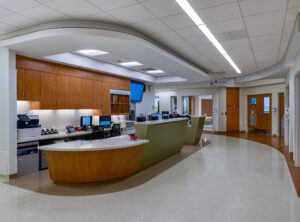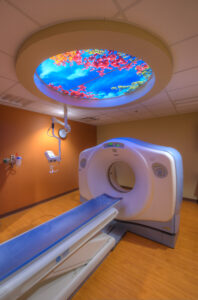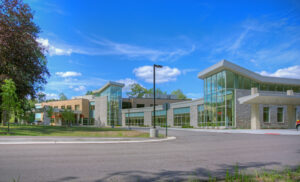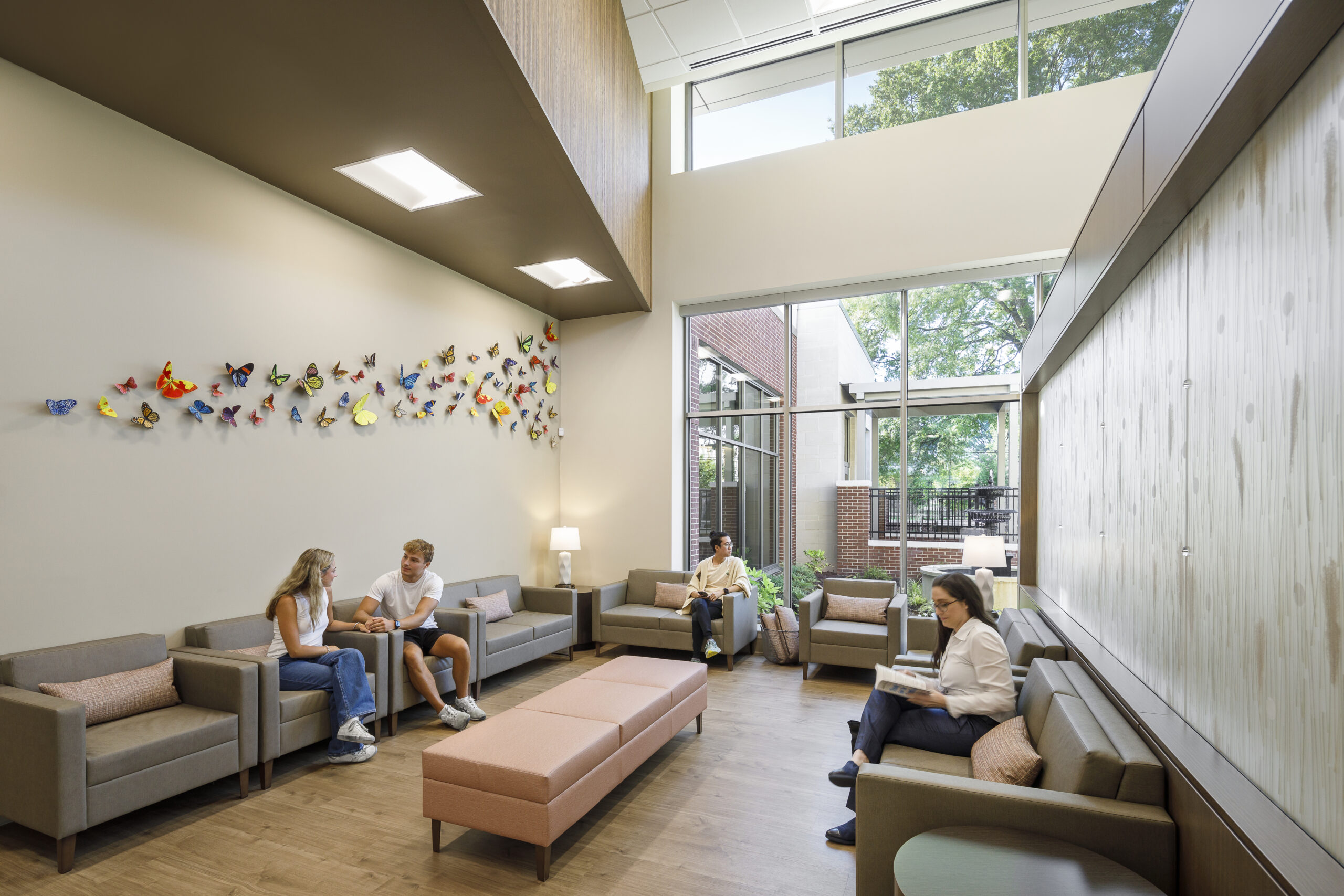Healthcare facility renovations or expansions require a nuanced understanding of logistics, compliance and collaboration. | Photo Credit: Hedrich Blessing Photographers
By Amanda L. Gorning
Healthcare facility renovations or expansions require a delicate balance between maintaining operational continuity and ensuring the highest safety standards. These complex projects require a nuanced understanding of logistics, compliance and collaboration. For healthcare leaders, navigating these challenges demands a holistic approach that integrates life safety planning, move management and stakeholder alignment.
The Intricacies of Move Management

Photo Credit: Hedrich Blessing Photographers
Renovating a healthcare facility while maintaining critical operations is like solving a three-dimensional puzzle. Departments must often be temporarily relocated, but this can’t happen arbitrarily. The first step is identifying which departments can be taken offline and which must remain operational. This requires strategic use of temporary spaces, such as relocating administrative offices to non-renovation areas to make room for critical departments.
Advanced Project Planning (APP) tools are invaluable here, enabling teams to overlay schedules, analyze sequences and set clear milestones. These steps ensure that disruptions are minimized while maintaining continuity of care. For example, in one large-scale project, the phased relocation of departments allowed critical care units to remain operational.
At the same time, administrative areas were temporarily shifted to modular units outside the main building. Such foresight ensures operational integrity and patient safety. The next crucial layer involves ensuring that all life safety measures are maintained and adapted dynamically throughout the construction process.
Egress and Life Safety Planning
Life safety planning ensures compliance and protects patients, staff and visitors during construction. Alternative egress solutions are essential considerations when construction barriers block primary exits. For instance, a loading dock door was repurposed as a temporary exit in one project and retrofitted with proper hardware, ramps and signage.
These efforts are coordinated with authorities, including fire marshals, to gain approval and prevent potential delays. Creating phased life safety plans that adapt to each stage of construction ensures that the facility remains safe and operational. Drawings illustrate egress flow and designate areas for phased closures, with regular updates based on construction progress.
These plans also incorporate flexibility to address unforeseen challenges, such as undocumented mechanical issues that might arise during the project. For example, outdated fire suppression systems not documented in the original drawings necessitated rapid adjustments to maintain compliance while avoiding project delays in a recent case.
With these measures in place, the success of life safety planning hinges on the strength of collaboration between stakeholders, making stakeholder engagement the foundation for seamless project execution.
Collaborative Stakeholder Engagement

Photo Credit: Chris Lark
Effective move management and life safety planning require input from a diverse group of stakeholders. Owners, construction managers and design teams often have dynamic interests that require balancing.
However, regular brainstorming sessions and transparent communication protocols help bridge these gaps. Early collaboration with jurisdictional authorities, such as fire marshals and state representatives, ensures alignment from the outset. This proactive approach mitigates compliance risks and fosters trust and cooperation among all parties.
Furthermore, engaging end users such as department heads and facility managers early in the process ensures that the planning aligns with the facility’s daily operational realities.
Collaboration lays the groundwork for addressing the unexpected, ensuring teams can pivot quickly and effectively when challenges arise.
Addressing Unforeseen Challenges
Even the most meticulous plans can be disrupted by unexpected issues. For instance, mechanical, electrical or plumbing (MEP) systems not reflected in existing drawings can necessitate immediate adjustments. Mechanical obstructions in ceilings may require teams to halt construction, reassess plans and implement alternative solutions.
Flexibility in scheduling and a robust contingency plan are critical for addressing these surprises. Thorough site assessments before construction can also help identify potential risks, minimizing the likelihood of disruptions.
Moreover, regular site walks and updates to as-built documentation can mitigate the risks of encountering undocumented conditions. One notable example involved rerouting medical gas lines mid-project when existing pathways conflicted with new ductwork installations.
The Impact of Long Lead Times

Photo Credit: Chris Lark
Photo Credit: Chris Lark
Delays in procuring materials and equipment, such as elevators or air handling units, are another significant challenge. Engaging design-assist partners early in the process can streamline procurement and reduce lead times.
Additionally, incorporating backup plans ensures that delays in one area don’t cascade into others. For example, preordering long-lead items such as custom medical equipment can synchronize their arrival with construction milestones, avoiding downtime. Additionally, leveraging modular construction techniques for specific components can offset delays in traditional construction.
Communicating the Vision
Healthcare leaders are concerned with a project’s operational aspects and perception among staff, patients and the community. Clear communication about the project’s benefits—from modern equipment to improved patient rooms—helps build enthusiasm and support.
Listening to stakeholders, engaging them in discussions, and presenting innovative solutions ensures that the project aligns with the facility’s goals and community expectations. For instance, a recent hospital expansion included community open houses where stakeholders could view renderings and provide feedback. This transparency fostered trust and garnered broad support for the project.
Delivering Value Through Innovation
A commitment to innovation and adaptability is at the heart of successful move management and life safety planning. By leveraging tools like APP, fostering collaboration and maintaining open communication, healthcare leaders can confidently navigate even the most complex projects.
The challenges posed by healthcare facility renovations are significant, but so are the opportunities. These projects improve operational efficiency and patient safety and position facilities as leaders in their communities. By adopting a holistic approach, healthcare leaders can ensure that their projects deliver lasting value—for their organizations, patients and the broader community.
Move management and life safety planning are not merely logistical exercises but critical components of a healthcare facility’s success. Through strategic planning, collaborative engagement, and a steadfast commitment to innovation, healthcare leaders can transform challenges into opportunities, creating environments that are not only safe and functional but also inspiring and patient centered.
Effectively embracing and leveraging complexity is key to excellence in every project phase. Ultimately, healthcare facilities must balance operational demands and long-term goals. By focusing on human-centered care, maintaining transparent communication, and proactively addressing challenges, healthcare leaders can deliver transformative projects that meet the needs of all stakeholders.
With the right approach, these projects can serve as benchmarks for innovation, resilience and excellence in the healthcare industry, mastering the art of adaption.
Amanda L. Gorning, AIA, LEED AP, NCARB, is healthcare studio leader and principal with Albert Kahn Associates, an architecture, design and engineering firm. She can be reached at amanda.gorning@akahn.com.






